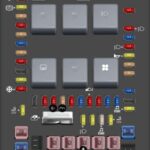The OBD2 port, standard on most vehicles since 1996, including Nissan models, provides a crucial interface for diagnosing car problems. Understanding the Obd2 Pinout Nissan configuration is essential for effectively using diagnostic tools and troubleshooting issues. This article delves into the specifics of the Nissan OBD2 pinout, outlining the function of each pin and providing valuable insights for both DIY enthusiasts and professional mechanics.
Decoding the 16 Pins of the OBD2 Connector in Nissan Vehicles
The OBD2 connector, a trapezoidal 16-pin port usually located under the dashboard on the driver’s side, facilitates communication between the vehicle’s onboard computer and diagnostic equipment. Each pin serves a specific purpose:
- Pin 1: CHECK – Reserved for manufacturer-specific use.
- Pin 2: J1850 Bus+ – Used for data transmission in vehicles employing the J1850 PWM communication protocol. Not typically used in Nissans.
- Pin 4: CGND – Chassis Ground, provides a ground connection for the circuit.
- Pin 5: SGND – Signal Ground, provides a ground reference for signals.
- Pin 6: CAN High (J-2284) – High speed CAN bus data line, common in later Nissan models.
- Pin 7: K-Line (ISO 9141-2 and ISO/DIS 14230-4) – Data line for ISO 9141-2 and ISO 14230-4 (KWP2000) protocols, common in earlier Nissans.
- Pin 8: Ignition ON – Indicates when the vehicle’s ignition is switched on.
- Pin 9: ABS (Reserved) – May be used for manufacturer-specific ABS diagnostic data.
- Pin 10: J1850 Bus- – Used for data transmission in vehicles employing the J1850 PWM communication protocol. Not typically used in Nissans.
- Pin 11: Adjust Switch – Reserved for manufacturer-specific use.
- Pin 12: SCI TX (Reserved) – Reserved for manufacturer-specific use.
- Pin 13: SCI RX (Reserved) – Reserved for manufacturer-specific use.
- Pin 14: CAN Low (J-2284) – Low speed CAN bus data line, common in later Nissan models.
- Pin 15: L-Line (ISO 9141-2 and ISO/DIS 14230-4) – Data line for ISO 9141-2 and ISO 14230-4 (KWP2000) protocols, common in earlier Nissans.
- Pin 16: +12V – Battery Power, provides constant power to the OBD2 connector.
OBD2 Protocols Used in Nissan Vehicles
Nissan has utilized various OBD2 communication protocols over the years, including:
- ISO 9141-2: Commonly found in Nissan models from 1996 to 2004.
- ISO 14230-4 (KWP2000): Also prevalent in models from 1996 to 2004.
- CAN (Controller Area Network): Became the standard for most Nissan models from 2005 onwards.
Knowing the specific protocol used in your Nissan model is vital for selecting the correct diagnostic scanner.
Utilizing the OBD2 Pinout for Diagnostics
Understanding the obd2 pinout nissan allows you to:
- Read and clear Diagnostic Trouble Codes (DTCs): Identify the source of malfunctions within the vehicle’s systems.
- Monitor live data streams: Observe real-time sensor readings for various parameters like engine speed, coolant temperature, and oxygen sensor voltage.
- Perform advanced diagnostics: Conduct tests on specific components and systems, depending on the capabilities of your diagnostic tool.
Conclusion
The OBD2 port and its pinout configuration are indispensable for diagnosing and repairing modern Nissan vehicles. By familiarizing yourself with the function of each pin and the communication protocols employed, you can effectively leverage diagnostic tools to maintain and troubleshoot your Nissan. Remember to consult your vehicle’s specific repair manual for detailed information and always exercise caution when working with electrical systems.


